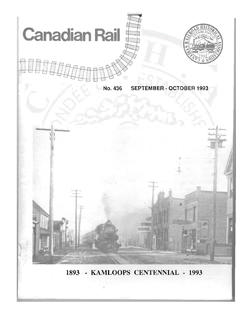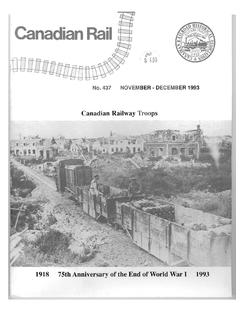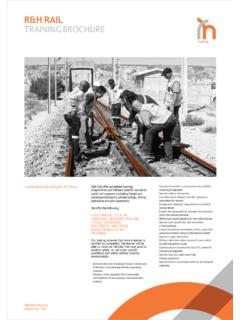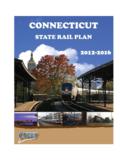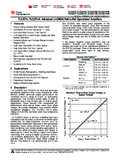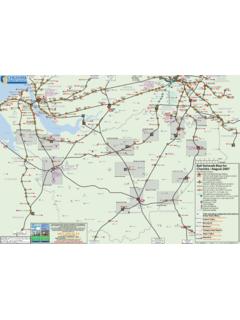Transcription of 29/10/18 Heritage Series - PC-Rail Services
1 PC-Rail Timetables Additional Information 28/06/18 Heritage Series The PC-Rail Heritage Series re-creates busy mechanical Signal boxes with large lever frames controlling the layout. Layouts are authentic and trains operate to appropriate timetables. The simulations incorporate working block instruments and bells. Barnham Timetables [P1] Weekday 1979/80 At last, a full 24 hour timetable for our popular Barnham simulation! As in the standard timetable , some passenger trains split and join here. With a total of 269 trains to handle, the signalman is kept busy! Most trains are of course formed of electric multiple units, while loco-hauled traffic is handled by BRCW Class 33 diesels and Class 73 Electro-Diesels.
2 [P2] Weekday Summer 1953 A welcome addition for this popular simulation, this timetable goes back to Coronation year. The frequent Southern Electric service was formed of an earlier generation of stock dating back to the thirties. Best of all, though, is the wide range of steam traction to be seen at work on passenger and freight Services . Relive the days of the West Countries, LBSC tanks, King Arthurs, Brighton Atlantics, and many more. [P3] Weekday 1997 A more recent timetable but busy as usual. EMU Class s 421, 422 and 423 form the backbone of the passenger service. [P4] Saturday 2002/03 A modern timetable with modern motive power to suit. With a total of 313 trains this forms the largest timetable created for Barnham.
3 Can you handle it. [P5] Weekday Winter 1995 This timetable was the last to have scheduled 4-CAP operation. Although mainly scheduled for shuttles between Bognor / Barnham / Littlehampton, one was scheduled to go to/from Brighton each day. They also strayed onto 4-VEP workings, not only on Coastway Services but to London as well! All were replaced by 4-VEP's by December, 4-VEP's also strayed onto 4-CAP workings, but the scheduled type is given in this timetable . [P6] Weekday 1975 A busy schedule as always on the Southern, with plenty to keep you on your toes. Passenger Services , mainly in charge of the EMU Classes 411, 414 and 423. However, there are some loco-hauled trains hauled by the Class 33 and the 73 Electro Diesels.
4 Even the Class 37 s make an appearance on some freight duties. [P7] Weekday 1930 The earliest timetable for Barnham produced so far! Back to a era of pure steam only, the timetable is compiled from platform working and signal box documents for Barnham and Ford with locomotives allocated from information of the era. [P8] Weekday 1987/88 This Time Table is based on the 1987/8 Passenger and Freight WTTs. All the "Q Runs as Required" traffic is running and some additional trains have been added. These are representative of what was running at the time and are mostly from the Authors personal PC-Rail Timetables Additional Information experience having driven Loco hauled trains in the area at the time and the period shortly after this timetable , although the times have been altered to fit in with the 1987/8 timings.
5 The stock in use at the time for the passengers was the Southern Region 1963 stock, VEPs, CEPs, BIGs etc., in 4, 8 or 12 car formations. The locomotives are mostly the Southern`s own Class 33 "Cromptons" and the Class 73 "ED", though by this date other region locos were showing their faces more and more and this is represented by the Class 47 "Brush" and the Class 56 on an aggregate train. Bath Green Park Timetables [I1] Summer Saturday 1961 On Summer Saturdays, freight trains were cancelled to provide paths for the numerous holiday expresses entering and leaving Green Park. It was on these busy summer Saturdays that Bath became a "Mecca" for railway enthusiasts.
6 In most cases, expresses heading southwards to Bournemouth over the steeply-graded S&D line required double heading. Many classes of engines could be seen, hauling coaches packed with families from the cities of the Midlands and North distant parts of Britain heading for their holiday on the south coast. Pigeon specials were also a regular feature of summer Saturdays and these too are included in this fascinating timetable . [I2] Weekday Summer 1970 Operating any timetable at Bath Green Park is challenging. This 1970 version is of course fictitious and represents what might have been if the S&D hadn't been closed in 1966. Thought provoking! [I3] Weekday 1922 A unique and interesting period.
7 Smart working is required to turn round trains and forward planning is needed due to the restricted movements possible. Locos in use are of course of the correct period. [I4] Weekday 1951 Another excellent timetable for this popular Heritage simulation. Based on the working timetable for Weekdays in 1951, it contains 180 trains, all steam-hauled of course. One of the many interesting features is the inclusion of the banking locos which were used for all goods trains departing on the Somerset & Dorset line. Ely North Junction Timetables [V1] Weekday 1968 Set beneath the wide East Anglian skies it would be an idyllic life for the signalman here, were it not for the frequent interruptions caused by the ringing of block bells and the passing of trains.
8 The drivers of each expecting to be given the correct route! Times were changing, though - already by 1968 diesel traction had taken over all traffic and steam was just a memory. But it was a different scene to the present day, with well over half the traffic being freight and more than half the passenger trains were loco-hauled. The most common loco classes were the Brush Type 2 and English Electric Type 3, with the earlier EE Type 4's in charge of the long-distance cross country expresses between Scotland and the north of England and Harwich, Colchester and Yarmouth. [V2] Weekday 1947 Back to those classic days of East Anglian steam - taken from the last LNER timetable before nationalisation.
9 PC-Rail Timetables Additional Information [V3] Weekday 188/89 This timetable is is taken from British rail working timetables section LB dated 3rd Oct 1988-14th May 1989 for passenger and parcel trains and section LD dated 3rd Oct 1988 for freight trains. The particular day of the week this timetable represents is a Thursday. Class 156 sprinter units are in use on cross country Services some reversing at Ely. London Liverpool St to Kings Lynn Services are worked by class 47/4 diesel locomotives. Local Services are worked by class 101 Metro-Cammell units. Freight trains are worked by locomotive classes 31,37,47 and 56. Evercreech Junction Timetables [AD1] Summer Saturday 1957 Summer Saturdays on the Somerset and Dorset were a complete contrast to normal weekdays.
10 Freight during daylight hours was almost non existent. What freight did run would need banking up to Binegar. The banking loco would normally attach to the rear end in the station. Because it is not possible in Heritage simulations to have a loco at each end of the trains the banker is presumed to be able to attach in the M Yard. The banked trains contain a note of the banker. Instead was a Series of Class 1 Expresses from the Midlands , North West and Yorkshire to Bournemouth. All of these would need additional pilot locos over the Mendip hills between Bath and either Evercreech Junction or Templecombe. For this extra pressure on the loco department additional motive power was called for. In 1957 this consisted of 4 West Country pacifics from Bournemouth and 2 British Railways standard class 4 2-6-0 locos from Eastleigh.
